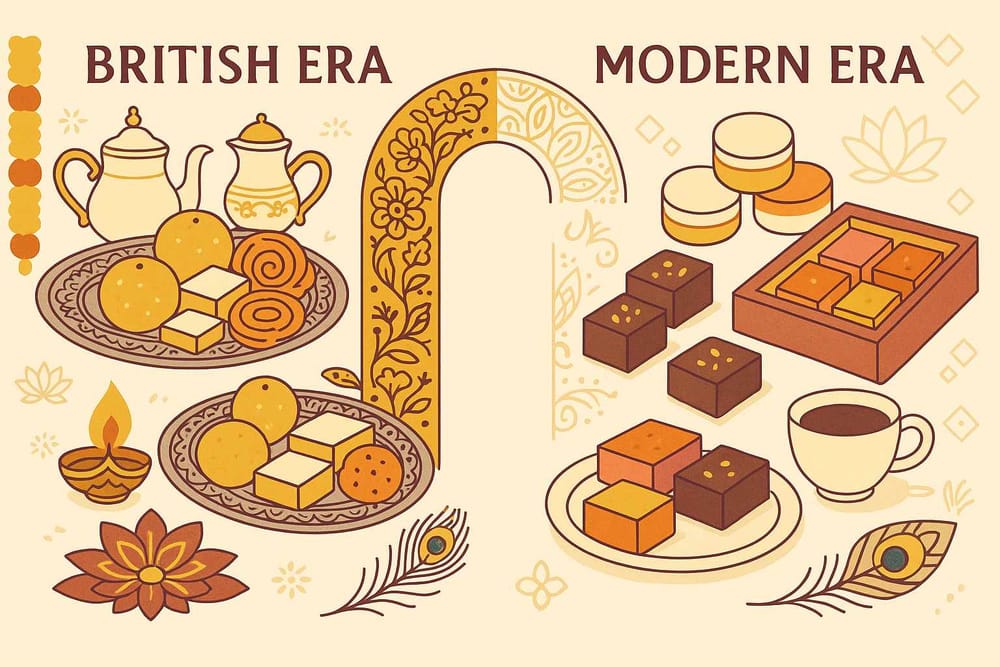
Sweet Legacy- Mithai from British Rule to Today: Understand the Evolution
Close your eyes for a moment and think of a celebration. What’s the first aroma that comes to mind? For many of us, it’s the comforting smell of ghee, sugar, and milk simmering together, the promise of a delicious mithai waiting to be shared. Indian sweets are not just food; they are woven into the very fabric of our lives. They are the taste of festivals, the sweetness of new beginnings, and the comfort in shared moments of joy. But have you ever wondered about the story behind your favourite barfi or ladoo? It’s a fascinating tale of tradition, innovation, and cultural exchange that has been unfolding for centuries.
Before the British Raj: The Ancient Roots of Mithai
Long before the first British ships arrived, India had a rich tradition of sweet-making. In ancient times, our ancestors used nature's bounty to create delights. Honey, jaggery (gur), and fruits were the original sweeteners. Temple kitchens were the heart of this culinary art, where offerings like the humble yet divine modak were crafted for the gods. The arrival of the Mughals brought a wave of new influences. They introduced us to the luxurious flavours of saffron, the richness of dry fruits, and the fragrant essence of rosewater, transforming simple sweets into decadent royal treats. Many of our cherished mithais, like Gulab Jamun, trace their lineage back to this glorious era.
A New Chapter: The British Influence on Our Sweet Traditions
The British era, from the early 1800s to 1947, marked a significant turning point in our culinary history. It wasn't an overhaul, but rather a fascinating period of blending and innovation that subtly reshaped our relationship with mithai.
- The Sugar Revolution: The establishment of sugar mills during this time made refined sugar cheaper and more accessible than ever before. Suddenly, mithai was no longer just a luxury for the wealthy; it became an everyday indulgence for many, finding its way into more homes and hearts.
- A Fusion of Flavours: The British brought with them their love for baking and dairy products like cream and butter. This sparked a creative exchange in Indian kitchens. Our brilliant halwais began experimenting, leading to unique hybrid sweets. Imagine the creamy texture of a British pudding meeting the desi richness of halwa—this was the kind of magic being created!
- Connecting India, One Sweet at a Time: The expansion of the railways was another game-changer. Suddenly, Bengal's famous rasgulla could travel to Delhi, and Mathura's iconic peda could be enjoyed in Mumbai. This incredible connectivity helped regional specialities gain nationwide popularity, uniting the country through its shared love for sweets. This reminds me of how today, we can still experience the sacred flavours of places like Udaipur, carrying on a tradition of sharing that began long ago.
- The Culture of Tea-Time Treats: The British also introduced their beloved tea culture, and what’s chai without a little something sweet? Light, crumbly biscuits like nankhatai became popular accompaniments, perfect for those evening gatherings and conversations.
Even amidst these changes, it's beautiful to see how our traditional mithais remained at the heart of our celebrations. Ladoos, barfis, and jalebis never lost their place. They co-existed with the new influences, becoming even more cherished during festivals and family functions. During the freedom struggle, mithai even became a symbol of unity, with ladoos being distributed to celebrate small victories and foster solidarity.
Mithai in a New India: Post-Independence and Beyond
After 1947, the Indian sweet industry blossomed. Family-run mithai shops, which had already grown popular, expanded their businesses. Industrialisation allowed for mass production, making our favourite sweets even more accessible without losing their traditional essence. Today, the legacy of that evolution is all around us.
We see it in the modern mithai shops that offer sugar-free options for the health-conscious. We taste it in fusion desserts that blend a classic jalebi with a contemporary cheesecake. The Indian sweets industry is now a multi-billion dollar market, but its soul remains the same. It’s still about celebrating life’s special moments, big and small. Every festival in India has its own signature sweet, a delicious tradition passed down through generations. These traditional sweets and dishes are the flavors of our festivals, connecting us to our roots and our communities.
Preserving Our Sweet Heritage with Bhaktilipi
Understanding the journey of our mithai helps us appreciate the depth of our culture. It’s a story of resilience, creativity, and the beautiful way our traditions can adapt and thrive. These recipes and the stories behind them are precious heirlooms.
At Bhaktilipi, our heart lies in preserving and sharing these timeless traditions. We believe that understanding our heritage enriches our lives and deepens our connection to our roots. Our platform is a dedicated space to explore the fascinating stories behind our devotional practices, rituals, and, of course, our culinary traditions.
To dive deeper into India's rich cultural tapestry, you can Learn More About Us and our mission. We invite you to stay connected with our community by subscribing to our YouTube channel for insightful videos and following us on Facebook and Instagram for daily inspiration.
Embracing the Sweetness of Our Story
From the simple honey-sweetened offerings of ancient India to the complex fusion desserts of today, our mithai has travelled through time, absorbing influences and telling the story of our nation. They are more than just desserts; they are symbols of togetherness, identity, and celebration. As we savour each bite, let's remember the rich history we are tasting and cherish this sweet heritage, ensuring it continues to bring joy for generations to come.
A passionate group of people dedicated to preserving India's knowledge of Dharma, Karma, and Bhakti for ourselves and the world 🙏.
